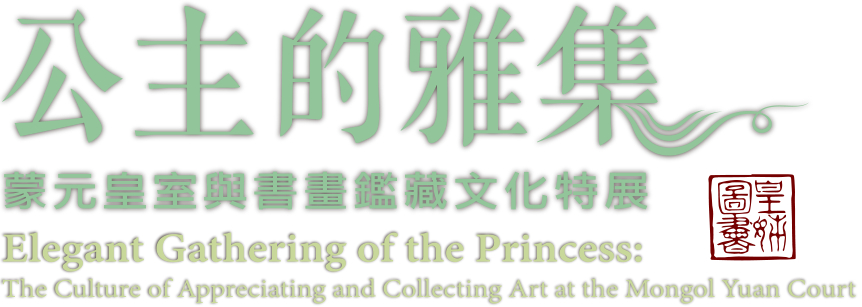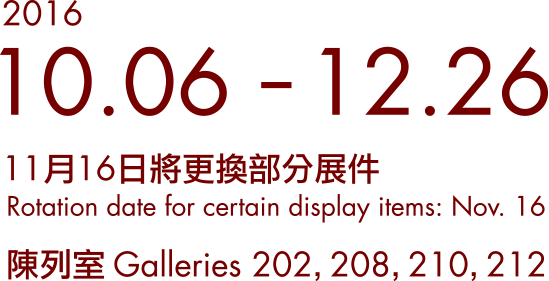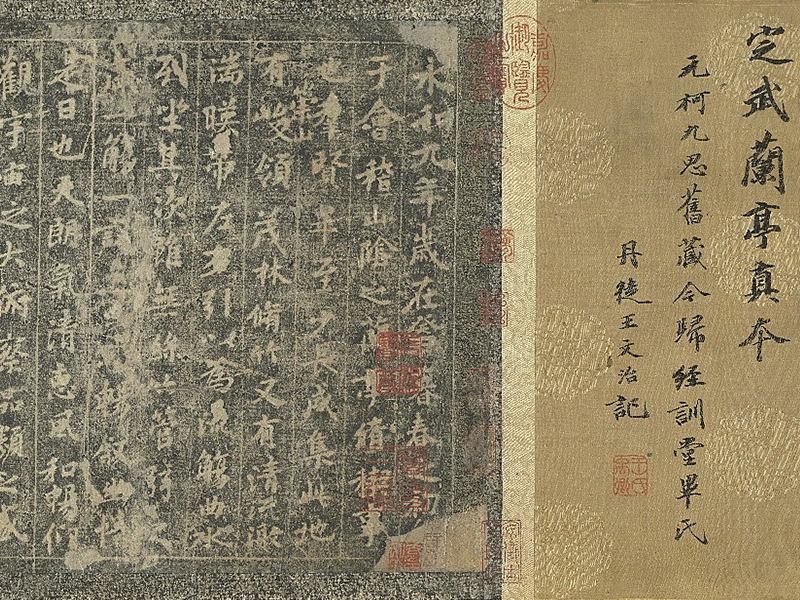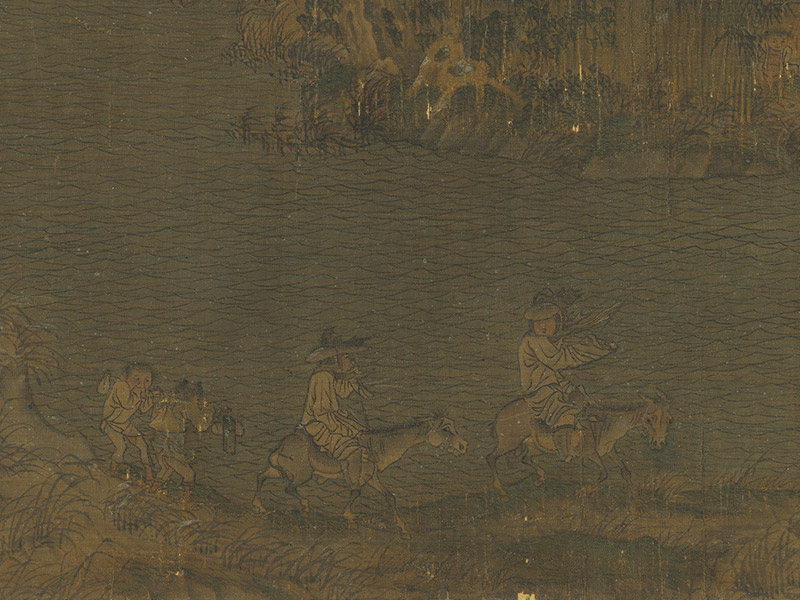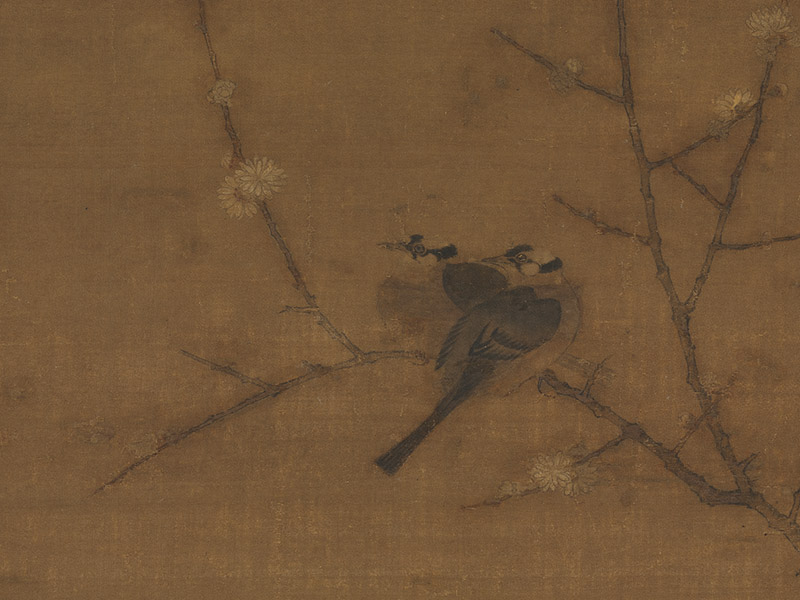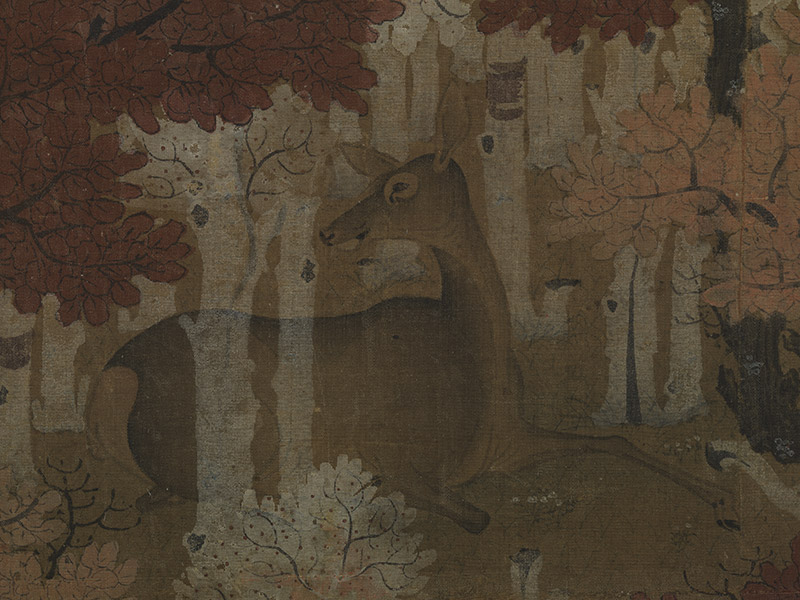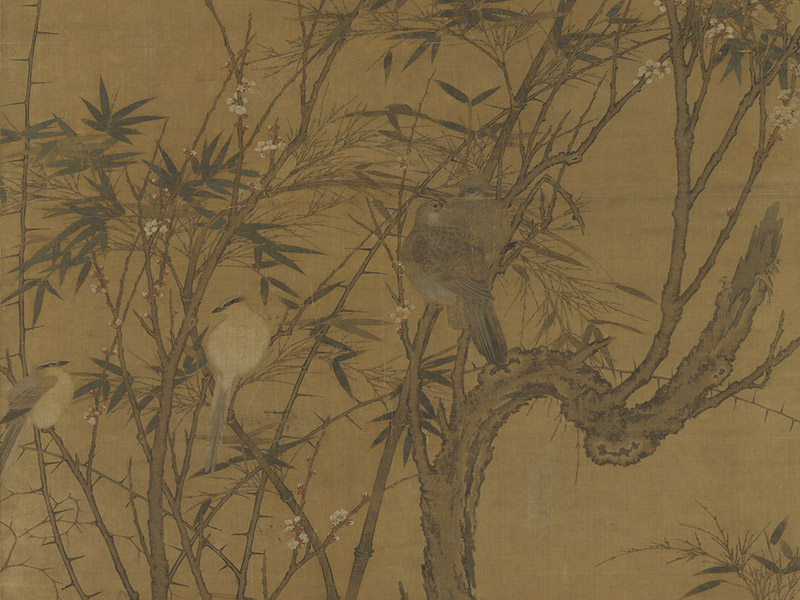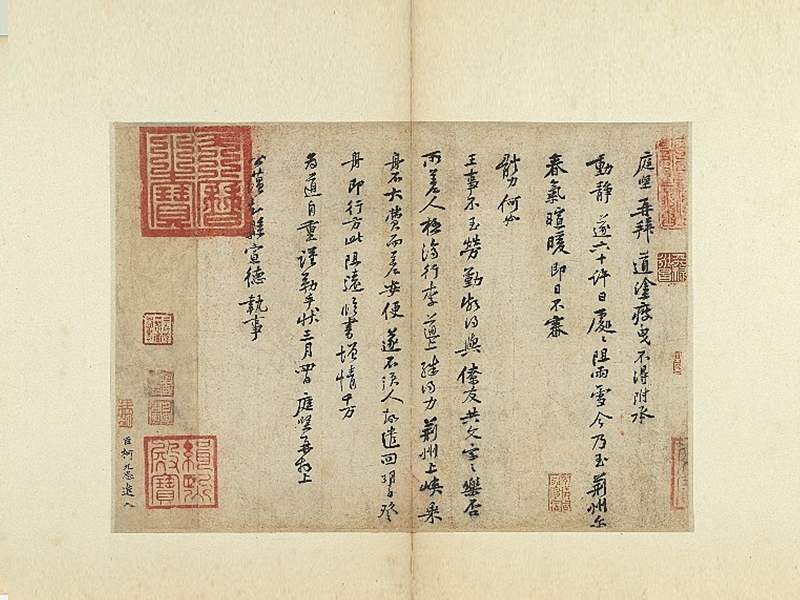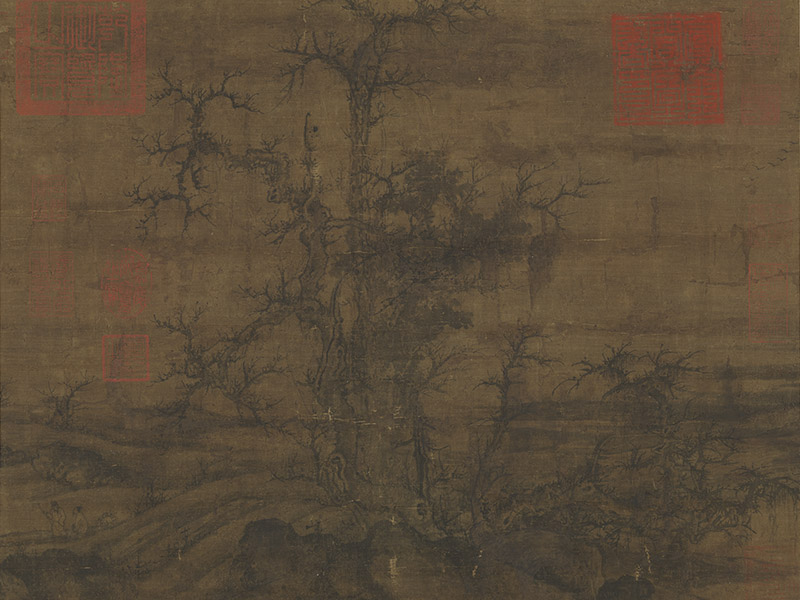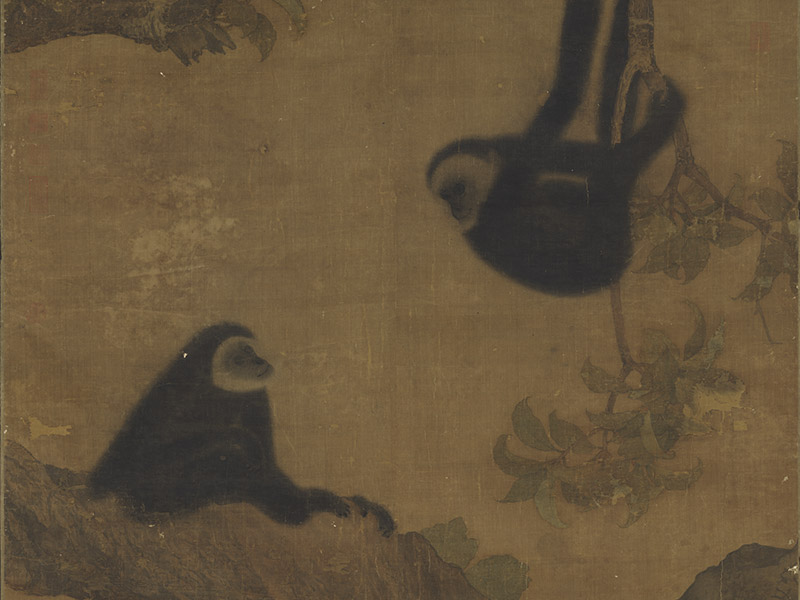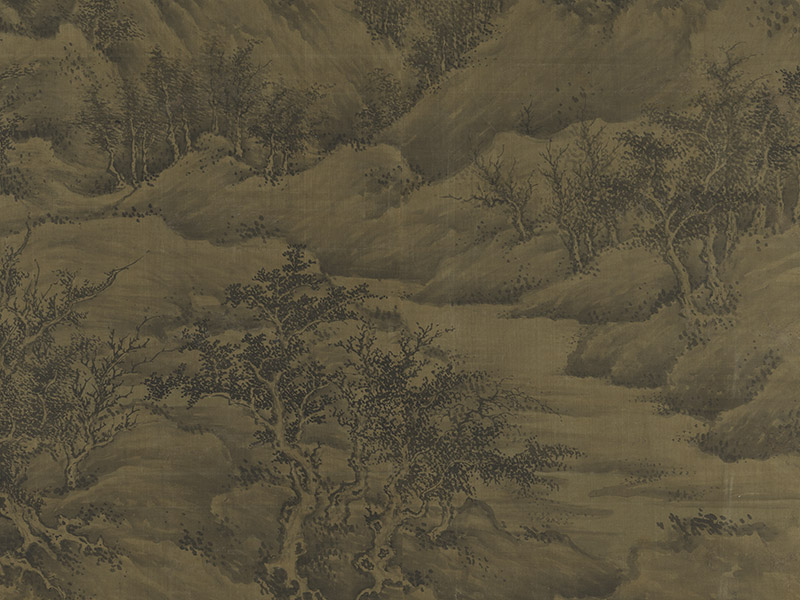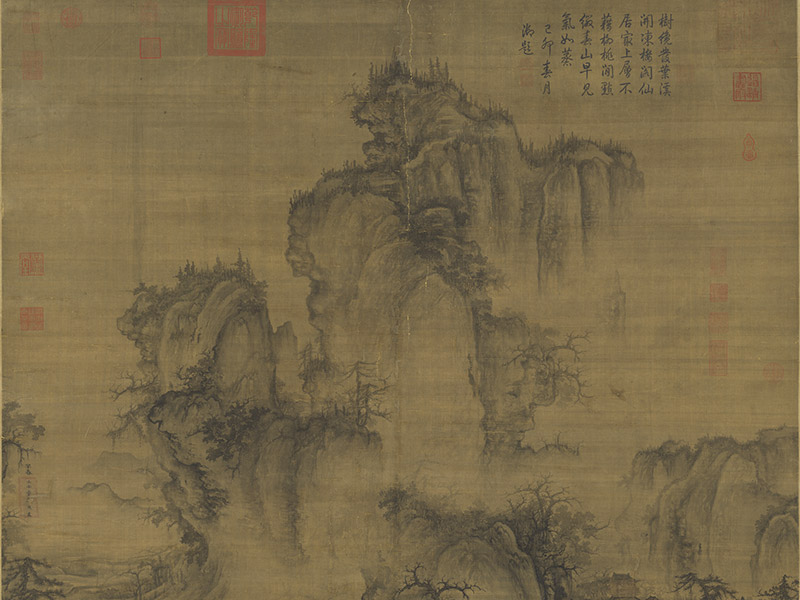Besides Princess Sengge Ragi, other Mongol rulers also exhibited a strong interest in collecting Chinese painting and calligraphy. For example, her son-in-law, Emperor Wenzong (Tugh Temür, r. 1328-1332), was an important patron of Chinese art. He established the Kuizhang Pavilion ("Hall of Literature"), which housed his large collection of painting and calligraphy managed by the scholar-official Ke Jiusi. Wenzong used such seals as "Treasure of Tianli (Tianli zhibao)" (referring to his reign name) and "Treasure of Kuizhang (Kuizhangge bao)." The former appears on Zhao Gan's "Early Snow on the River," now regarded as an early masterpiece of Chinese painting, and at the end of the scroll are signatures for numerous officials at the Kuizhang Pavilion. "Chimonanthus and Birds" by the Song emperor-artist Huizong also features these two seals, further helping to reconstruct the extent of Wenzong's collection.
The last emperor of the Yuan dynasty, Shundi (Togon Temür, r. 1333-1370), engaged as well in collecting activities as ruler of China and was able to ascend to the throne with the support of Wenzong's empress. In 1340, he disbanded the Kuizhang Pavilion to establish the Xuanwen Pavilion ("Hall for the Diffusion of Literature"), which also was staffed with numerous scholars. Shundi's seal, "Treasure of the Xuanwen Pavilion (Xuanwenge bao)," can be seen on such anonymous Song dynasty paintings as "Gibbons Playing in a Loquat Tree" and "Intimate Scenery of Wintry Trees," indicating they were once in his collection.
Original Dingwu Copy of the Orchid Pavilion Preface
Rotation 2 11/16-12/26
- Anonymous, Tang dynasty (618-907)
- Handscroll, ink on paper, 25 x 66.9 cm
This particular rubbing, judging from the features of the copy, its inscriptions, and the seals, appears to date from the eleventh century, which would make it the only and most complete surviving one that exists today. The handscroll has the "Treasure of Tianli" seal of the Yuan emperor Wenzong (Tugh Temür), and Princess Sengge Ragi is recorded to have had a "Dingwu Copy of the Orchid Pavilion Preface" in her collection, indicating that certain members of the Yuan imperial clan placed great emphasis on Chinese culture, as represented by this rubbing of the "Orchid Pavilion Preface."
Early Snow on the River
Rotation 2 11/16-12/26
- Zhao Gan (fl. 10th c.), Five Dynasties period
- Handscroll, ink and colors on silk, 25.9 x 376.5 cm
This scroll was originally in the collection of the Jin dynasty emperor Zhangzong (r. 1189-1208) and presented by academicians at the Kuizhang Pavilion in the Yuan dynasty to the emperor in 1329. Emperor Wenzong (Tugh Temür) inscribed and ranked the painting as in the "Divine Category, Upper." His view demonstrates the Yuan court's acceptance of Chinese heritage while solidifying his own image as a culturally inclined ruler.
Chimonanthus and Birds
Rotation 1 10/6-11/15
- Huizong (1082-1135), Song dynasty
- Hanging scroll, ink and colors on silk, 83.3 x 53.3 cm
Here, the birds appear relaxed and at ease. Although in the past they had been compared to the affection of a husband and wife, indirect evidence of this work as part of a set would suggest that the court used this subject to symbolize a country at peace with scholars in harmony. The painting also has the two seals for "Treasure of Tianli" and "Treasure of the Kuizhang Pavilion" from the reign of Emperor Wenzong (Tugh Temür) in the Yuan dynasty, indicating it was once in his collection.
Herd of Deer in a Maple Grove
Rotation 1 10/6-11/15
- Anonymous, Five Dynasties period (907-960)
- Hanging scroll, ink and colors on silk, 118.5 x 64.6 cm
The style of this work is unique in that virtually no blank space has been left in the composition, which is filled with a herd of deer in a forest of dazzling colors. The original colors of the tree trunks have almost all but flaked off, leaving only the light underlying hues. The colors of the leaves are red, light pink, white, and blue, creating an unusual surface effect. Another painting in the collection of the National Palace Museum, "Herd of Deer in an Autumnal Grove," is very similar in style, these two scrolls probably once having belonged to the same set.
Plum Tree, Bamboo, and a Gathering of Birds
Rotation 1 10/6-11/15
- Anonymous, Song dynasty (960-1279)
- Hanging scroll, ink and colors on silk, 258.4 x 108.4 cm
Previous scholarship has dated this scroll to the Northern Song period (960-1127), but the direct and succinct brushwork for the slope and the poses of the birds are more commonly seen in works from the Southern Song (1127-1279) Painting Academy. Furthermore, the composition of crisscrossing branches and trunks is reminiscent of Liu Songnian's "Lohan" painting. In the lower left corner is "Treasure of the Qixi Hall," a collection seal of the Southern Song emperor Lizong. It thus perhaps came from the hand of an artist from the middle Southern Song around the turn of the thirteenth century. It is also impressed with the "Treasure of Tianli" and "Treasure of the Kuizhang Pavilion" collection seals of Emperor Wenzong (Tugh Temür) in the Yuan dynasty.
Jingzhou Modelbook
- Huang Tingjian (1045-1101), Song dynasty
- Album leaf, ink on paper, 31.2 x 43.2 cm
At the top of the work are a collection seal of the Southern Song court, "Treasure of the Qixi Hall," and one for "Treasure of Tianli" from the reign of Emperor Wenzong (Tugh Temür) in the Yuan dynasty. In the lower left corner is an inscription that reads, "Presented by Your Servant, Ke Jiusi." The evidence here indicates that this piece of calligraphy had been in both the Southern Song and Yuan imperial collections and authenticated by Ke Jiusi, who managed Wenzong's collection. The letter was later included in "Album of Calligraphy by Twelve Song Masters."
Intimate Scenery of Wintry Trees
Rotation 1 10/6-11/15
- Anonymous, Song dynasty (960-1279)
- Hanging scroll, ink and light colors on silk, 42.2 x 49.2 cm
This painting has no seal or signature of the artist, but the arrangement of the tree branches is similar to that of "crab-claw" trees in the Northern Song landscape tradition of Li Cheng and Guo Xi. The composition of trees forms and slope motifs also relates to the left part of the Guo Xi painting "Old Trees, Level Distance," now in the Metropolitan Museum of Art in New York, suggesting the period of production for both as being around the same time. The silk here, however, appears to have been restored with brushwork by a later hand. At the top of the painting is a collection seal of the Yuan dynasty emperor Shundi (Togon Temür), "Seal of the Xuanwen Pavilion Library." The scroll later entered the imperial collection of the Ming dynasty.
Gibbons Playing in a Loquat Tree
Rotation 2 11/16-12/26
- Anonymous, Song dynasty (960-1279)
- Hanging scroll, ink and colors on silk, 165 x 107.9 cm
The rendering in this painting is exquisite, the effect of the gibbons' fur exceptionally detailed as the artist used short and delicate brushstrokes in different directions to suggest the forms. Complemented by fine gradations of layered ink, the gibbons' limbs and bodies are clearly defined in a spatial relationship, marking this as a masterpiece of Song dynasty painting. This work had been impressed with a seal for "Treasure of the Xuanwen Pavilion," indicating it was in the collection of the Yuan emperor Shundi (Togon Temür).
Rivers and Mountains, Forests and Marshes
- Attributed to Juran (fl. 10th c.), Five Dynasties period
- Hanging scroll, ink on silk, 221.3 x 119.7 cm
Some of the ink dots for the trees in the mountains, however, appear slightly flat and formulaic, suggesting some distance in terms of time from such Juran landscape paintings of the Northern Song as "Xiaoyi Acquiring the ‘Orchid Pavilion Preface' by Deception." Consequently, the scroll here dates slightly later than the twelfth century. It is also impressed with a seal for "Treasure of the Xuanwen Pavilion," meaning it was part of Emperor Shundi's (Togon Temür) collection in the Yuan dynasty.
Early Spring
Rotation 2 11/16-12/26
- Guo Xi (ca. 1023-1085), Song dynasty
- Hanging scroll, ink and light colors on silk, 158.3 x 108.1 cm
The composition of this painting is more or less symmetrical, but the rounded mountain forms complemented by rich atmospheric effects of clouds and mist add considerable rhythm and dynamism to an otherwise orderly arrangement. The balance of light and dark ink washes creates a delicate shimmering of light, increasing the illusory and mystical quality of the space. Appearing here and there are also fisherman, woodcutters, and travelers, adding a touch of life and spirit to the scenery. The scroll is impressed with a seal for "Imperial view in the Mingchang (reign)," indicating it had passed through the imperial collection of the Jin dynasty in the north before entering the Yuan court. Afterwards, it became a part of the Ming imperial collection.
